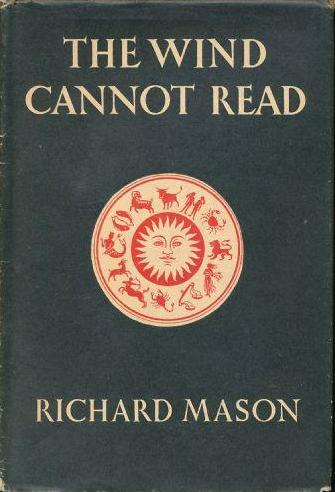 1948 Reprint Society hardcover edition (UK)
1948 Reprint Society hardcover edition (UK)
Copped and cropped from AbeBooks.com
Mammy Bears Books, Cedar Creek, QLD, Australia
|
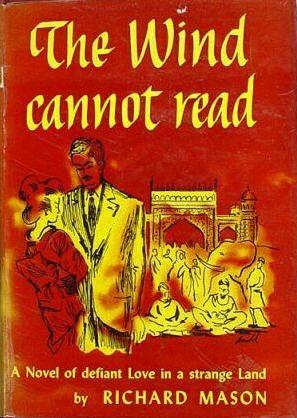 1957 Putnam hardcover (US)
1957 Putnam hardcover (US)
Copped and cropped from AbeBooks.com
|
 Jacket of 1950 (6th) Hodder & Stoughton hardcover edition, Yosha Bunko scan
Jacket of 1950 (6th) Hodder & Stoughton hardcover edition, Yosha Bunko scan
|
 One of several German editions
One of several German editions
denn der Wind kann nicht lesen
1950 Buchgemeinschaft Donauland edition
Copped and cropped from AbeBooks.com
Little Stour Books, Canterbury, United Kingdom
|
 2017 Bello paperback edition (UK)
2017 Bello paperback edition (UK)
Yosha Bunko scan
|
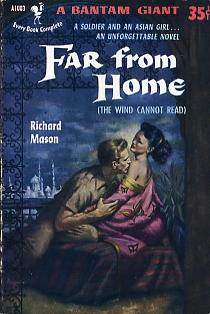
|
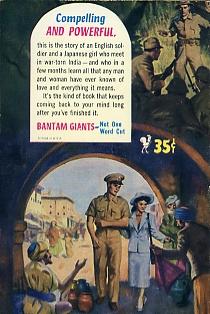
|
|
Unpoetic Far From Home retitling of The Wind Cannot Read
1952 Bantam Books paperback edition, Yosha Bunko scans
Title possibly inspired by Vern Sneider's short story "A Long Way From Home"
published in April 1951 Argosy, collected in 1956 anthology of same title
|

|

|
|
1952 Pan paperback edition, Yosha Bunko scan
Wartime manuscript finally approved by censors
|
 The World of Suzie Wong, 1957 Collins hardcover edition, Yosha Bunko scan
The World of Suzie Wong, 1957 Collins hardcover edition, Yosha Bunko scan
|
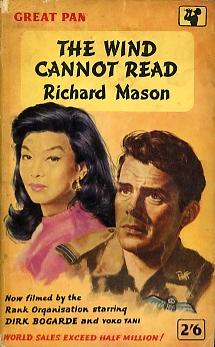 1958 Pan Books paperback (UK)
1958 Pan Books paperback (UK)
Movie tie-in cover
Yosha Bunko scan
|
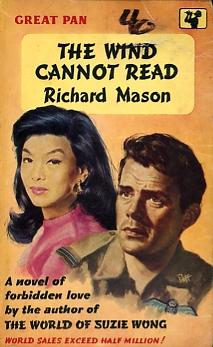 1960 Pan Books paperback (UK)
1960 Pan Books paperback (UK)
Suzie Wong tie-in cover
Yosha Bunko scan
|

|

|
|
Click on images to enlarge
1958 Portuguese novelization of film as O Vento não Sabe Ler
Front and back covers, pages 2 and 3, Yosha Bunko scans
|

1966 Hodder & Stoughton hardcover edition (UK)
Copped and cropped from AbeBooks.com
Biblioteca di Babele, Tarquinia, VT, Italy
|

|

|

|
|
1969 (2nd) edition of 1966 Hodder paper edition (UK), Yosha Bunko scan
Though on the sign it is written / "Don't pluck these blossoms" --
it is useless against the wind / which cannot read
|

|

|
|
British film adaptation of
The Wind Cannot Read
released in Japan as
風は知らない
Kaze wa shiranai
[ The wind doesn't know ]
Top right
"Kaze wa shiranai" theme song
Sung by Peggy Hayama ペギー葉山
Lyrics by Aoba Takashi 青羽たかし
Arrangement by Ishikawa Akira 石川皓也
Released by King Records (EA63)
Right
Poem that inspired original title
"Though on the sign it is written:
'Don't pluck these blossoms' --
it is useless against the wind,
which cannot read."
-- Japanese poem --
この花は かたく折るなと
いう たてふだも
よめぬ風には ぜひもなし
Yosha Bunko scans
|

|
Film release publicity
The newspaper advertisement to the right -- implicitly published in the Friday, 28 November 1958 edition -- publicizes the start of the Tōwa Films roadshow release in Japan of The Wind Cannot Read as Kaze wa shiranai (風は知らない) -- "The wind doesn't know" -- from Saturday, 29 November 1958, at the Shōchiku Central Theater in Tokyo.
The film is billed as a British production by Arthur Rank, directed by Ralph Thomas, and starring Dirk Bogarde (Daaku Bogaado ダーク・ボガード) and Yoko Tani (Tani Yōko 谷洋子), with Ronald Lewis and Anthony Bushell.
The story blurb structurally translates as follows (my translation).
The painfulness of a love that intensely burns in the mysterious country of India amidst the fires of war. A sorrowful international romance overflowing with exotic sentiments (ikoku jōcho 異国情緒 "different-country emotions").
The original story is attributed to Richard Mason, and the attribution parenthetically notes that it has been published [in translation] by Tōhōsha (東宝社)
The theme song has been released by King Records (Kingu Rekoddo キングレコード).
Tōwa Films (東和映画) began in 1928 as Tōwa Shōji (東和商事) as a distributor in Japan of first German then other foreign movies. It became Tōwa Eiga in 1951 and just Tōwa from 1960. Since 1975 it has distibuted foreign films as a subsiderary of Tōhō called Tōhō-Tōwa.
Shōchiku Central Theater (Shōchiku Sentoraru Gekijō 松竹セントラル劇場), which at its peak could sit 1000 viewers, was closed in 1999.
Yosha Bunko scan
|

|

Jacket of DVD edition of movie version of The Wind Cannot Read
Produced in Barcelona nlt 2018, Yosha Bunko scan
|

|

|
|
4th (1907) edition of
Basil Hall Chamberlain's
A Handbook of Colloquial Japanese
Images cropped from Internet Archive scans
Upper right
Colophon showing Chamberlain as both the author and the publisher of the 4th (1907) edition. First published in 1888 and republished in 1889 and 1896. Chamberlain was residing in Fujiya Hotel in Miyanoshita in Onsen-mura in Sagami-no-kuni in Kanagawa prefecture, as an "Englishman" (英國人 Eikokujin) -- signifying his legal status.
Right
Chamberlains's translation of
dodoitsu that inspired title
The Wind Cannot Read
(5) "Kono hana wa
(7) Kataku oru na!" to
(7) Iu tate-fuda mo,
(7) Yomenu kaze ni wa
(5) Zehi mo nashi."
Even a board stuck up and
inscribed with the words "It is
strictly prohibited to pluck these
blossoms" is useless as against
the wind, which cannot read.
|

|
Mason_1949_Kaze_wa_shiranai_1953_Vol_1_Bio_yb.jpg
Mason_1949_Kaze_wa_shiranai_1953_Vol_1_Jacket_obi_yb.jpg
Argosy_1951-04_050-051_Long_Way_from_Home_yb.jpg
Richard Mason
The Wind Cannot Read
Richard Mason (1919-1997) wrote The Wind Cannot Read while serving in India and the Burma theater during the Pacific War. It was published in December 1946 though most early editions state January 1947 or simply 1947.
This novel is the most important work of romantic British wartime fiction to come out of the Pacific War. It preceded by a decade the publication of Mason's The World of Suzie Wong, which is arguably the most important work of romantic British fiction related to postwar East Asia. The only contemporar novel to clearly eclipse the impact of these two works was James Michener's Sayonara, published in 1953 and released as a film on 5 December 1957 in the United States. The film adaptation of The Wind Cannot Read was released on 29 November 1958 in Japan. The World of Suzie Wong was released on 10 November 1960 in the United States.
The Wind Cannot Read received the 1948 John Llewellyn Rhys Prize.
Hardcover editions
London: Hodder & Stoughton, 1947 (December 1946)
London: The Reprint Society, 1948 (Book club)
296 pages, hardcover
New York: Putnam, 1947
296 pages, hardcover
Paperback editions
New York: Bantam Books, 1952
308 pages, paperback (A1003)
1st U.S. paperback edition retitled
Far from Home (The Wind Cannot Read)
London: Pan Books, 1952
256 pages, paperback (206)
London: Pan Books, 1958 (2nd printing)
271 pages, paperback (G119)
Cover: "Now filmed by the
Rank Organisation starring
DIRK BOGARDE and Yoko Tani"
[Cover illustration shows drawings of
Bogarde and Tani as Quinn and Sabbi]
London: Pan Books, 1958 (6th printing)
271 pages, paperback (G119)
Cover: "A novel of forbidden love
by the author of
THE WORLD OF SUZIE WONG
[Cover illustration shows drawings of
Bogarde and Tani as Quinn and Sabbi]
London: Bello (Pan Macmillan), 2017
321 pages, paperback (POD)
Poetic title
The title page quotes the poem from which the title is taken.
"Though on the sign it is written:
'Don't pluck these blossoms' --
it is useless against the wind,
which cannot read."
-- JAPANESE POEM
The poem is also cited on the top of the back cover, under the banner FORBIDDEN!. The poem is followed by this summary of the plot. .
MICHAEL QUINN, RAF, plucks the forbidden blossom when on an Intelligence course in India he and his Japanese girl-instructor fall passionately in love.
Their brief happiness is interrupted when, sent to the Burma front, he is captured by the Japanese.
He escapes -- but returns to find Fate waiting.
From jungle to language school
Quinn has had to retreat with the unit he had been stationed with in Burma when Japanese forces invade the country. Months later he makes it through the jungle to India -- exhausted, weak with dysentery, and full of thoughts of those who had been left behind with a few rounds of ammunition "to use as they like on the Japs and themselves" (page 5).
After being officially grounded by a medical board in New Delhi, he is sent to Bombay to study Japanese so he can interrogate prisoners. The hotel where he and others in his group will be staying is run by a woman called Miss Jackson (page 20).
She was an Anglo-Indian, thirty-five perhaps, with Jewishly handsome features that showed signs of softening and running to seed; but there was a ripe attraction about her still.
The men are given a test. Characters are written on the board and quickly erased. Other characters are written on the board with numbers. Write the numbers of the characters in the second set that were also in the first set.
Quinn doesn't do too well, but he says he has ears than eyes, so he is put in the half of the class that will focus on speaking, while others will concentrate on reading.
Itsumi San's thin skin
Their chief instructor is a Brigadier general who is fluent in Japanese. He is assisted by several Japanese instructors. One of the assistants is a man named Mr. Itsumi -- "or Itsumi San as we called him, for San was the Japanese equivalent to Mr." (pages 28-29).
He was only twenty-nine or thirty, with an owlish student's face. He had been studying British business methods in England, and on the way back to Japan when the war started, his ship had docked in India. He had been released from internment to teach us.
He was strikingly yellow. I had not met many Japanese, and I did not know that they were really this colour, a deep brown-yellow. When he was angry it turned to a grey-yellow, and that happened often, for he easily took offence. I suppose it was an inferiority complex. He would misunderstand a word, and believing himself to be insulted would fall suddenly silent and nurse a grudge for days.
Miss Wei's shyness
Another assistant instructor is a woman named Miss Wei. One day she comes into the classroom with the Brigadier (pages 31-32).
Of course the Brigadier had told us before: "Wei is a Chinese name. She is using it because it is not advisable to have a Japanese name now. But Miss Wei is Japanese -- you will find she speaks the best Tokyo language." That is all he had told us. We had waited expectantly; most of us had never seen a Japanese woman before.
We were all silent, watching her. She stood nervously by the Brigadier, looking at the corner of the desk, very slim and tiny in a light summer frock.
"I will introduce you," the Brigadier said. "This is Miss Wei."
We murmured, "Good morning."
"Good morning," she said with her lips, and gave a quick little stoop, a suggestion of a curtsy.
"Miss Wei has come all the way from England to help us out." He smiled at her gallantly and gratefully. She smiled too, dropping her eyelids in self-depreciation. Then she sat down next to him behind the desk.
There were general signs of approval: Miss Wei had passed the first test -- she was pretty. She was a spot of fresh colour in the schoolroom, with its blackboard and its piles of books and its tables and its inkpots. For a time nobody looked out the window, and there was a certain amount of winking.
"She is exquisite!" Peter whispered.
"Yes," I said.
"We are going to have delightful classes."
"We probably will."
"Once she has got over her shyness," he added.
It was not surprising that she was shy when there were ten of us there, ten strange faces ranged in front of her. Ten of us judging her critically as a woman.
Mason is very good at evoking mood. The characters of the officers that figure in the story are all carefully and well developed. If Itsumi San represents the sort of Japanese that the officers find difficult to like (though they cannot quite hate him either), Miss Wei tests their ability to regard as as something other than Japanese -- as a woman if not a exactly a person.
Within a few pages Quinn is getting to know more about Miss Wei after class. His friends kid him about Miss Wei but he insists he is not chasing the Japanese lady (page 48).
Indian and English women
One Saturday Quinn and two classmates go to the races. Mario wants to see "beautiful women in smart clothes, women who would remind him of European capitals." Peter "wanted to make money" and had a system. And Quinn himself was going because "he had no system for anything and could think of nothing better to do."
The racecourse is crowded, the grandstand is full of Maharajahs, and the men are in a paddock thanks to badges they'd been given by the Brigadier (page 49).
Isn't it simply marvellous," Mario said. "I love to be amongst the best people."
"It's excellent," Peter said. "You see, the Indians have best people too. I'd got it all wrong. I thought all Indians were babus and sweepers."
There was plenty of colour for Mario. All the Indian women were wearing their silk saris, very soft and colourful, and wholly feminine; the English women moved amongst them like a different sex, half-way to masculinity. These Indians seemed to glide as they moved, and the diaphanous material, exquisitely bordered in silver or gold, floated behind them; they stood in twos and threes like bunches of soft-petalled flowers. Mario was smiling his white Latin smile with aesthetic delight.
Sabby and Michael
A number of pages later Quinn and Miss Wei get down to the serious business of naming each other (page 67).
When you laugh you're very happy. But there is also part of you that's sabishii."
"I don't see how you know."
"It's because you have expressive eyes."
"I shall wear spectacles, and then I shall become real schoolmistress. I shall use stick."
"You'll still feel the same," I said.
But you will not know how I feel behind the spectacles."
"Do you mind my knowing?"
"Not if you don't care about sabishii."
"I think it's very beautiful and soulful," I said. "I'm going to call you sabishii. Only it had better be Sabby for short. Sabby! That's rather a good name -- perhaps better than your real name."
"My real name is Hanako."
"The Flower Child! That's a good name, too. But I'm going to call you Sabby."
"I already know what you are called," she said.
"Quinn is such an easy name to remember."
But I also know your other name, because your friend always uses it as school. It is Michael."
The tension in this novel builds to an incredible height. The tragic ending does little to relieve it, making it unlikely that anyone who has read this novel will forget it. Mason's ability to pull this off testifies to his skill as a writer.
And Two Shall Meet
Reminiscent of the manner in which Hanako hides her illness from Quinn, both Lilly and Richard, the star-crossed lovers in Raymond Mason's And Two Shall Meet (1954), hide their mortal conditions from each other.
Mason on writing "The Wind Cannot Read"
Richard Mason (1919-1997) was 19 when World War II began. Later in the war, he says, he was sent to "a school of oriental studies in London to learn Japanese to go out to the East and act as an interpreter and to interrogate Japanese prisoners of war" (Guy Haydon, "About the Author", in Suzie Wong, Hong Kong: Pegasus, 1994).
Mason says he wrote The Wind Cannot Read when he was 23, while living in a tent in Burma, on a portable typewriter.
The movie
Hal Erikson's "All Movie Guide" includes this summary of the 1958 British film starring Dirk Bogarde as Quinn and Yoko Tani as Sabby.
The Wind Cannot Read
1958-UK-War Drama
N.Y. Times Review
PLOT DESCRIPTION
The Wind Cannot Read is a tearful British star crossed romance effort set against the backdrop of World War II. RAF officer Dirk Bogarde is assigned to learn Japanese in order to interrogate prisoners. His language instructor is the lovely Yoko Tani, daughter of an anti-Tojo businessman. Bogarde and Tani fall in love and secretly marry. Not long afterward, Borgarde [sic] is captured and tortured by the Japanese. While listening to the POW camp radio loudspeaker, he hears the voice of Tani, broadcasting anti-British propaganda. At first heartbroken, Bogarde vows to be reunited with Tani when he discovers that she is dying from brain disease. Escaping from the camp, Bogarde finally makes his way to the hospitalized Tani, where they share a tender moment before death enshrouds her. Richard Mason based his script for The Wind Cannot Read on his own novel.
-- Hal Erickson, All Movie Guide
|

























